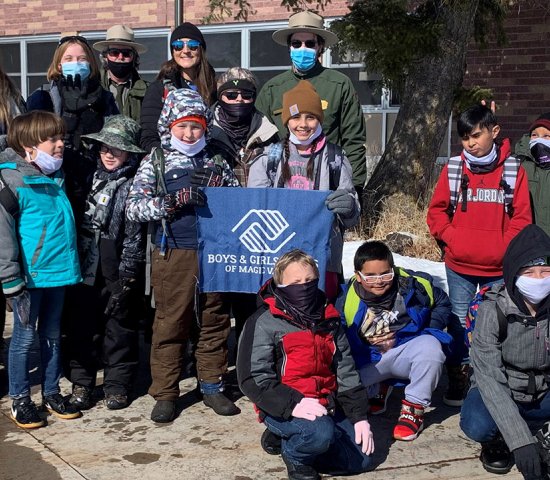
The National Environmental Education Foundation (NEEF) is proud to announce the awardees of the NPS-21st Century Community Learning Centers (CCLC) Greening STEM Grant.
This is the second round of grants provided under a collaborative partnership between NEEF, the National Park Service (NPS) and the US Department of Education (ED) to deliver STEM programming that engages youth from underresourced and/or underrepresented communities using NEEF's Greening STEM model.
The grants will provide place-based after-school education programs to students participating in 21st CCLC programs, which provide federal funding for academic enrichment opportunities during non-school hours. Students will participate in citizen science, environmental monitoring, and other STEM activities at NPS sites across the country.
“We are excited to have several newly formed NPS-21stCCLC partnerships among the second cohort of grantees, which includes a couple of repeats as well,” said Robert Sendrey, program director for K-12 environmental education at NEEF.
Programming funded by these grants will utilize STEM-focused content, hands-on inquiry-based instructional strategies, professional development workshops, and collaboration and dissemination technologies to assist 21st CCLC center directors and staff in implementing and enhancing after-school and/or out-of-school STEM programs.
The following seven projects were selected to receive NPS-21st CCLC Greening STEM Grant funding:
Establishing a Community-Based Youth Citizen Science Program at Colorado National Monumentâ¯â¯
Grantee: Colorado National Monumentâ¯
Partner: Riverside Educational Center, Grand Junction, CO
This project aims to activate and empower local youth as stewards and 21st century problem solvers. Through implementation of the Greening STEM model, students will participate in citizen science and engage with resource management issues. In addition to the experiential component, this project will address inequity in outdoor spaces. Riverside Education Center is a recognized diversity and inclusion community leader, serving a greater portion of Latinx youth than any other local organization.â¯
The Lost Carnivores of the Tucson Mountains: Understanding the Disappearance of 5 Small Carnivores
Grantee: Saguaro National Parkâ¯
Partner: Roadrunner Elementary School and Altar Valley Middle School, Tucson, AZ
As part of science-based research within National Parks, Saguaro National Park brings students to the park as citizen scientists to engage in real, place-based STEM/scientific research that is seamless from the classroom to the field. The Lost Carnivores program exposes youth to park management principles through using wildlife cameras both in the park and at their school. They will collect real data to help the park determine if five small species of carnivores still exist in the park and if not, what happened to them, and what might the park do. Students gather data, research and analyze the data, and draw conclusions regarding the missing species.â¯â¯
Seasonal Change: Monitoring the NYC Environment for Climate Changeâ¯
Grantee: Gateway National Recreation Areaâ¯
Partner: Academics in Motion and Counseling in Schools, New York, NYâ¯
Through the NPS-21st CCLC Greening STEM Grant Program, Gateway National Recreation Area will establish a phenology monitoring program and collect data on the presence of animal pollinated plants and their pollinators that can be replicated in years to come. Animal pollinated plants are of specific concern, as changes in bloom times due to climate change can break the evolutionary relationship between animal pollinators, resulting in ecological crisis.â¯
Introduce Elementary Students to Citizen Science through STEM Activities at Homestead National Historical Parkâ¯
Grantee: Homestead National Historical Parkâ¯
Partner: Beatrice Public Schools, Beatrice, NE
This project will bring Greening STEM programming to local 21st CCLC 3rd-5th grade students through high-quality learning experiences that use the local park environment as a tool for improving student learning and achievement in science. Four to five member teams of third, fourth, and fifth grade students will investigate and monitor biodiversity within Homestead NHP. After exploring the diverse habitats within the park, student teams will identify one location--a square meter--as their team's monitoring site. The focus on life in a square meter allows students to make careful observations over time and gain a connection to and appreciation for the living things found in small spaces that often are overlooked.â¯
Greening STEM with the Knoxville Boys and Girls Clubâ¯
Grantee: Great Smoky Mountains National Park
Partner: Boys and Girls Clubs of the Tennessee Valley, Knoxville, TNâ¯
This project will weave STEM learning into recreational activities like horseback riding, hiking, and bike riding. Through these STEM Exploration breaks, the students will use the scientific method to experience the park and its resources through the eyes of a scientist. Students will collect data for on-going citizen science projects and, through that interaction and closer connection with the resources, to develop stewardship behaviors.â¯
Learning Treesâ¯
Grantee: Cuyahoga Valley National Parkâ¯
Partner: Greater Cleveland Neighborhood Centers Association, Cleveland, OHâ¯
Local middle school students will plant and monitor native trees across the seasons, collecting and analyzing data to inform future projects. Reforestation is critical to the mission of Cuyahoga Valley National Park and provides an excellent conduit to standards-based community science and monitoring projects. The project will increase standards-based STEM literacy in local urban students through tree planting and soil monitoring in Cuyahoga Valley National Park while helping develop a scientifically robust and replicable community science monitoring project.â¯
Bay Area Discovery Museum & SF YMCA Environmental After School Programsâ¯
Grantee: Golden Gate National Recreation Areaâ¯
Partner: YMCA of San Francisco, San Francisco, CA
This project will provide hands-on STEM programming for students in after school programs expose students to California's coastal ecosystem and engage them as stewards and supporters of this critically important ecosystem. The project seeks to introduce and engage them with scientific studies of the ocean and shore, support their sense of belonging to nature, and broaden their perception of who they are and who they can become in relation to their local environment.â¯
>> Learn more about NEEF Grants